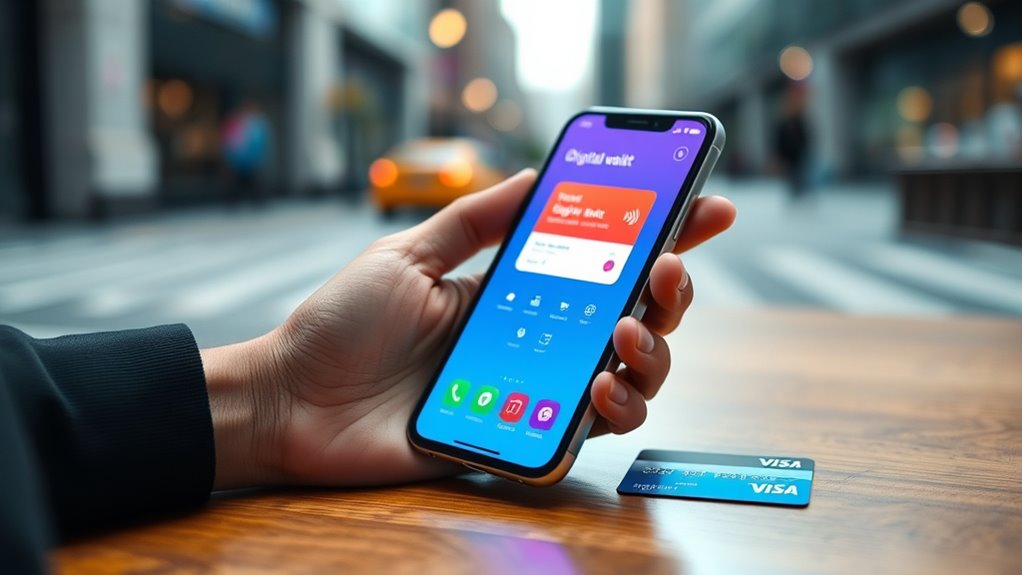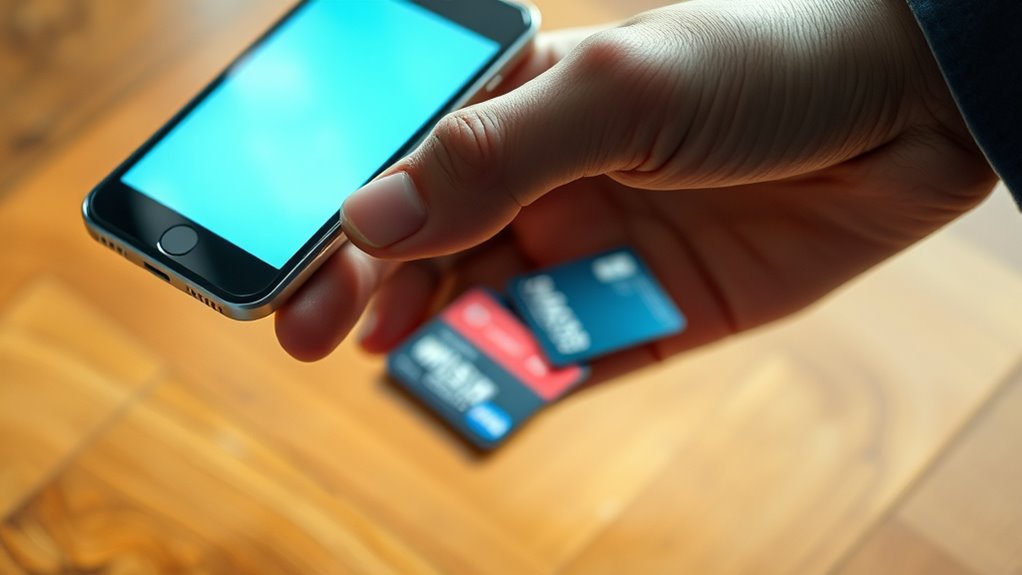Digital wallets are rapidly replacing physical cards, offering a more convenient and secure way to pay. With contactless technology, you can tap or scan devices for quick transactions, reducing the need for carrying cards. Advanced security measures protect your sensitive info, giving you control and peace of mind. As these solutions become more widespread, cards may become less essential in everyday transactions. If you want to understand how this shift impacts your payment options, keep exploring more insights.
Key Takeaways
- Digital wallets offer faster, contactless transactions, reducing the need for physical cards in everyday payments.
- Enhanced security features like encryption and biometric authentication make digital wallets safer than traditional cards.
- Increasing merchant adoption of contactless payments accelerates the shift away from physical cards.
- Digital wallets support a cashless society, encouraging users to rely less on physical payment methods.
- Over time, digital wallets are expected to replace physical cards, becoming the primary mode for digital and in-store payments.

Have you ever wondered how you can make payments quickly and securely without carrying cash or cards? That’s where digital wallets come in, revolutionizing the way you handle transactions. With just a tap or a glance, you can pay for your coffee, groceries, or even your transit fare. Contactless payments, enabled by digital wallets, are now common at many stores and public transport systems, allowing you to skip the hassle of fumbling for cash or cards. It’s fast, convenient, and reduces the time you spend at checkout lines. But as this technology gains momentum, you might start to wonder about the security concerns associated with digital wallets. Is your money really safe? Are there risks of hacking or fraud? These are valid questions, especially since digital wallets store sensitive information like your credit card details or bank account credentials. However, the technology behind digital wallets employs strong security measures, such as encryption and tokenization, to protect your data. When you use contactless payments, your actual card details are not transmitted; instead, a unique token is sent, making it difficult for cybercriminals to steal useful information. Plus, many digital wallets require biometric authentication—like fingerprint scans or facial recognition—adding an extra layer of security. This means you’re not just relying on a PIN or password, which can be guessed or stolen. As a user, you also have control over your digital wallet. You can set up alerts for transactions, monitor your activity in real time, and quickly disable access if you suspect any fraud. Additionally, ongoing security developments continue to improve the safety of digital wallet transactions. So, while concerns about security are understandable, the industry continually updates its protocols to make digital wallets safer. As technology advances, many see digital wallets as a natural evolution of financial transactions. They offer a level of convenience that traditional cards can’t match, especially as more merchants adopt contactless payment options. You’ll likely find yourself using your digital wallet more often, especially since it minimizes physical contact—an important consideration in today’s health-conscious world. Over time, the reliance on physical cards might diminish as digital wallets become more integrated into everyday life. They’re becoming a key part of cashless societies, making transactions seamless and efficient. For many, the shift away from physical cards isn’t just a trend but a practical move towards a more secure and frictionless way of paying. So, whether you’re paying at a store, online, or on public transit, digital wallets provide a quick, secure, and contactless payment method that’s reshaping how you handle money every day.
Frequently Asked Questions
How Secure Are Digital Wallets Against Hacking?
Digital wallets are quite secure against hacking because they use advanced encryption methods to protect your data. Plus, biometric security features like fingerprint or facial recognition add an extra layer of protection. You should still stay cautious, avoid unsecured networks, and keep your device’s software updated. While no system is completely invulnerable, these measures make digital wallets a safer choice compared to traditional cards.
Can Digital Wallets Work Offline Without Internet Access?
Ever wondered if digital wallets can function offline? Yes, they can handle offline transactions, especially if your device and wallet are compatible with NFC or Bluetooth. You just need to have the necessary data stored locally, like a token or encrypted info. Wallet compatibility is key—make sure your device supports these features. While online access makes transactions easier, offline functionality adds flexibility and security when connectivity’s limited.
Are Digital Wallets Accepted Worldwide or Only in Specific Regions?
Digital wallets have limited global acceptance, mainly thriving in regions with high digital adoption like North America, Europe, and parts of Asia. Regional adoption varies markedly, so you might find them widely accepted in some areas but not in others. While they’re expanding rapidly, it’s essential to carry traditional cards or cash when traveling to regions with lower digital wallet adoption. Always check regional acceptance before relying solely on digital payment methods.
What Are the Environmental Impacts of Digital Wallet Production?
Imagine your digital wallet replacing plastic cards, reducing waste. The environmental impact of digital wallet production is minimal compared to physical cards, mainly because it involves digital infrastructure rather than manufacturing materials. However, the production footprint of servers and devices supporting digital wallets still consumes energy and resources. Overall, digital wallets help cut down on plastic waste, but consider their energy use in data centers when evaluating environmental impacts.
How Do Digital Wallets Affect Traditional Banking Systems?
Digital wallets considerably impact traditional banking systems by accelerating digital banking adoption and fueling a cashless economy. You’ll find that transactions become faster and more secure, reducing reliance on physical cash and paper-based processes. Banks are adapting to these changes by offering integrated digital services, but it also challenges their traditional roles. Overall, digital wallets push you toward a more seamless, efficient banking experience while transforming how money circulates in society.
Conclusion
As you can see, digital wallets are transforming how you pay, making cards feel outdated. Imagine a world where your phone open your store, transit, and even your favorite cafes—no more bulky cards or cash. This shift isn’t just convenience; it’s a revolution in security and simplicity. Embrace the change, and you’ll see a future where digital wallets aren’t just optional—they’re essential, making traditional cards seem almost obsolete.









